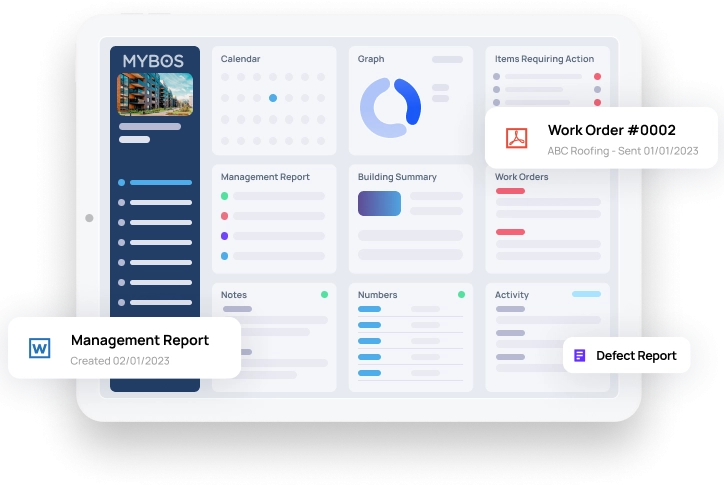
Outsourcing vs In-House Property Maintenance: Which Is Better for Your Building?
Effective property maintenance is essential not only for preserving the physical structure of a building but also for ensuring compliance, tenant satisfaction, and long-term asset value. When it comes to maintaining a property, building managers are faced with a crucial decision, should they manage everything in-house or outsource to specialised service providers?
According to CBRE’s Facilities Management Procurement Perspectives, the majority of respondents (58%) outsource their facilities management services, highlighting a trend towards leveraging external expertise for efficiency and cost-effectiveness. In many cases, the right facility manager software can further enhance these outsourced partnerships by streamlining communication, tracking performance, and improving overall operational control.
This article explores the advantages and challenges of both in-house and outsourced building maintenance approaches, helping you decide what’s best for your building.
Understanding Property Maintenance in Commercial Settings
Property maintenance for commercial buildings involves the strategic upkeep of all physical assets—mechanical systems, infrastructure, and common areas—to ensure operational efficiency, compliance, and tenant satisfaction. It includes preventive, corrective, and reactive tasks aimed at minimising downtime, extending asset lifecycles, and supporting long-term value. For facility managers, it’s a critical function tied directly to cost control, safety standards, and performance metrics.
In commercial environments, this includes a broad range of tasks such as:
Daily Tasks
- Inspect HVAC systems and check temperatures
- Respond to maintenance requests and service tickets
- Perform routine cleaning and sanitation of common areas
- Check lighting and replace burnt-out bulbs
- Inspect entryways, doors, and security systems
Weekly Tasks
- Test emergency lighting and exit signs
- Inspect plumbing for leaks or water pressure issues
- Conduct landscape and grounds maintenance
- Review inventory of maintenance supplies and tools
- Check elevators and other mechanical systems for irregularities
Monthly Tasks
- Perform preventive maintenance on HVAC and mechanical equipment
- Inspect fire safety systems (alarms, extinguishers, sprinklers)
- Review and update maintenance logs and compliance checklists
- Clean air filters and service ventilation systems
- Conduct roof and exterior inspections for damage or wear
Learn more about the three main types of maintenance strategies to understand where your building fits.
In-House Property Maintenance: Control and Familiarity
In-house property or facility maintenance involves a dedicated on-site team employed directly by the building or management company to handle all maintenance tasks, from routine inspections to emergency repairs. This setup allows for faster response times, better control over maintenance quality, and stronger familiarity with the property’s systems and needs. Teams will typically include general maintenance technicians, specialists (e.g., electricians, HVAC), and a supervisor managing schedules, compliance, and reporting.
Managing maintenance operations internally offers a number of potential benefits:
Pros:
- Full control over staff and schedules – You’re directly managing the team, ensuring alignment with building-specific needs.
- Quicker response times – On-site staff can react immediately to urgent issues.
- Greater familiarity with the building – In-house teams know the layout, systems, and historical challenges.
Cons:
- Higher fixed costs – Hiring, training, and retaining qualified staff can be expensive.
- Resource limitations – Internal teams may not have the tools or expertise for every job.
- Risk of burnout – Smaller teams often get stretched thin, especially during peak periods.
While in-house management provides greater control, it also requires a substantial investment in time and financial resources.
Colliers also highlights the importance of in-house teams in delivering exceptional customer experiences. They note that front-of-house staff receive extensive training on the property they’re within and any issues they may encounter, ensuring a high level of service and familiarity with the building’s specific needs.
Outsourcing Maintenance: Flexibility and Specialised Expertise
Outsourced property or facility maintenance involves contracting external service providers to handle maintenance tasks, either partially or fully, depending on the building’s needs. This setup allows building teams to scale resources, access specialised expertise, and reduce internal staffing overheads. Typically, a facility manager oversees the coordination of vendors, manages service-level agreements, and ensures compliance and performance standards are met.
Engaging third-party maintenance service contractors can be a game-changer, especially for buildings requiring a wide range of specialist services.
Pros:
- Access to a wider skill set – Contractors often bring highly specialised knowledge and equipment.
- Scalability – Easily adjust services based on demand or budget constraints.
- Cost-efficiency – Pay only for the services you need, when you need them.
Cons:
- Less control – Outsourced providers operate on agreed contracts, which may limit flexibility.
- Inconsistent service levels – Quality can vary depending on the provider.
- Onboarding time – Contractors require time to learn building-specific processes and nuances.
With the right partner, outsourced maintenance can significantly improve efficiency and performance, especially when paired with a robust software platform.
EY Australia reported that outsourcing internal functions and processes to a third-party managed services provider can offer several benefits, including supplementing internal resources and expertise, reducing budgetary expenditures, and improving overall efficiency. This approach allows organizations to focus on their core business while leveraging the specialized skills and technologies of external providers.
Preventive Maintenance: A Core Requirement, Regardless of Model
Preventative property or facility maintenance involves regularly scheduled inspections and servicing of building systems to prevent breakdowns, extend asset life, and ensure regulatory compliance. By proactively managing tasks like HVAC servicing, fire safety checks, and equipment calibration, building teams can reduce unplanned downtime, lower long-term repair costs, and maintain safety and tenant satisfaction. Whether in-house or outsourced, preventive maintenance helps improve operational continuity and minimise costly reactive repairs.
Recent findings from the Facility Management Association of Australia show that preventive maintenance can cut emergency repairs by up to 45%. This highlights the importance of a structured approach, no matter which strategy you choose.
For a deeper dive, see our guide on how to successfully manage preventative maintenance.
Key Factors to Consider Before Choosing
Before deciding which model works best, consider the following factors:
- Building size and complexity
- Budget constraints
- Type and frequency of services needed
- Staffing availability and expertise
- Compliance and safety regulations
For example, smaller buildings may benefit from the personal touch of in-house teams, while high-rise complexes often need the expertise that external contractors bring.
Hybrid Approach: The Best of Both Worlds?
The decision between outsourcing and in-house property maintenance isn’t one-size-fits-all. It depends on your building’s unique needs, available resources, and long-term goals. The right strategy will help ensure your commercial building upkeep remains consistent, cost-effective, and future-ready.
Some property managers are now adopting a hybrid approach—keeping a core in-house team for routine property inspections and minor fixes, while outsourcing more technical or large-scale tasks like HVAC servicing or electrical audits.
This approach can provide:
- Greater flexibility
- Reduced internal staffing costs
- A balance between control and expertise
If your building has diverse needs but limited internal capacity, this model might offer the optimal balance.
According to Deloitte’s report on hybrid service delivery models, organizations have achieved significant operational cost savings, over $200 million over five years by adopting flexible hybrid approaches that combine in-house capabilities with outsourced services. This model allows for greater adaptability and efficiency in service delivery.
How MYBOS Helps Streamline Property Maintenance Workflows
Whether you choose to outsource, stay in-house, or opt for a hybrid model, having a strong facility repair and management system is essential. MYBOS helps you:
- Schedule and manage preventive maintenance
- Track service providers and internal staff performance
- Automate routine inspections
- Centralise communications and documentation
By implementing smart software, you can ensure consistency, reduce manual errors, and improve visibility across all maintenance operations.
Ready to streamline your property maintenance processes? Book a demo today and discover how MYBOS can help you deliver smarter, more efficient maintenance outcomes.




